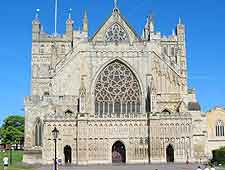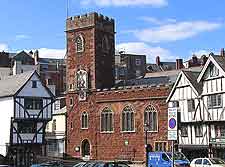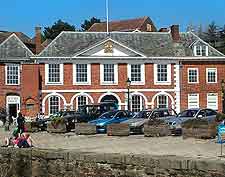Exeter History Facts and Timeline
(Exeter, Devon, England)

Exeter is one of the oldest cities in England, with a history that is thought to date back to Celtic times. Its location at a crossing point on the River Exe appears to have been particularly strategic, acting as a gateway to the whole of the south-west of England.
During Roman occupation, the Second Augustan Legion took advantage of Exeter's location, establishing a stronghold here. Around the 2nd century AD, a wall was built to protect the army within. Consequently, Exeter acquired a certain status within the region.
Saxons and Danes
The withdrawal of the Romans in the 4th century brought about the gradual disappearance of Roman civilisation. It wasn't until the arrival of the Saxons in the late 7th century that new life was breathed back into the city. Saxon rule was interrupted only by a short period of Danish occupation, which began in 876 AD. The Danes were eventually defeated by the Saxon king, Alfred the Great.

Medieval Exeter
The Normans arrived in the area soon after the Battle of Hastings of 1066. After a siege that lasted 18 days, King William finally took control of the city. To protect it from future rebellions, Rougemont Castle was built at the highest point on its walls. A period of expansion ensued, including the building of the Cathedral of St. Peter early in the 12th century. Exeter went on to become a great religious centre, with about a third of the walled town owned by the Church.
By the 13th century, Exeter had grown into a prosperous port. Then, in 1280, a weir across the river was built. Vessels could no longer reach Exeter, forcing them to stop at Topsham instead. The arrival of the weir appears to have been the entrepreneurial scheme of one Countess of Devon. In 1566, a ship canal was opened, meaning that Exeter could once again be reached by sea-going vessels. This is actually reputed to be the oldest post-Roman canal in Britain.

From Civil War to Victorian City
During the English Civil War, Exeter was besieged twice, first in 1642 and then in 1643. Despite great opposition by Parliamentarian supporters in the city, Royalist forces finally prevailed. In the meantime, much of the city was laid waste.
The Georgian era of history brought prosperity to the city. Thanks to a wealthy middle class who demanded elegant housing, the city expanded rapidly, with fine terraces and crescents being built outside of the city walls. The arrival of the Industrial Revolution during Victorian times brought more wealth. The Victorian love affair with railway building extended to the city in 1861. A station was first opened at St. David's. New streets were also laid out, including Queen Street. The Royal Albert Memorial Museum was built at this time, later housing a lending library, an art college and part of the University of Exeter.
20th Century Exeter
The outbreak of World War Two had a devastating effect on Exeter. In April and May 1942, the city was blitzed, with many historic buildings suffering extensive damage. In 1945, the Exeter Phoenix Plan outlined ideas for the city's reconstruction. By the mid-1960s, most of the damaged areas had been rebuilt.
 Exeter is one of the oldest cities in England, with a history that is thought to date back to Celtic times. Its location at a crossing point on the River Exe appears to have been particularly strategic, acting as a gateway to the whole of the south-west of England.
Exeter is one of the oldest cities in England, with a history that is thought to date back to Celtic times. Its location at a crossing point on the River Exe appears to have been particularly strategic, acting as a gateway to the whole of the south-west of England.
